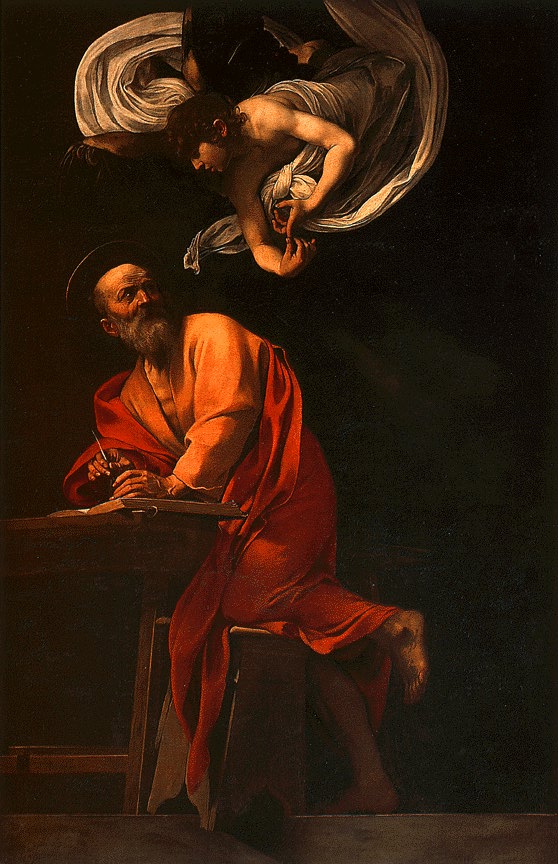indeed, I like him very much, but never truly in love with his paintings - despite the fact that he had many qualities to recommand him, such as the heightened theatricality and emotional charge, the provocative poses of the youths, his bold coloration, and the sleek beauty of the fabrics, fruits and other objects - all of which were solidly in the realm of my admiration.
Therefore, my attitude towards Caravaggio baffled even myself till recently.
I'm reading an art book, the Arts of Man, by Eric Newton, which traced the art development though styles and movements.

On page 170, it commented a painting by Caravaggio, "St. Matthew and the Angel", c. 1600:
It was probably painted in 1600. The Mannerism of late 16th Century was coming to an end. The baroque style that was to succeed it a few years later had not yet established itself. Caravaggio was a born rebel and his startling realism, which not only presented staints as peasants, with the faces and gestures of peasants, but portrayed them in the harsh cold light that we loosely call "pohotgraphic", at once shocked the conventional but soon delighted the adventurous.
Once his innovations were understood they spread like wildfire both to Holland, where a group of painters centered on the Utrecht imitated his choice of types and his sytem of dramatic lighting, and to Spain, where the yound Velasquez even outdid him in realistic intensity. There was a brief period during which it almost looked as though the new realism might become the accepted style of painting throughout Europe. But in the end the photographic vision of Caravaggio was superseded by the exuberance of Rubans and the profundity of Rembrandt. Velasquez, himself, eventually abandoned the harsh cold shadows of Caravaggio and worked out a new system. In his portrait of Queen Mariana, it is evident that the influence of Caravaggio has at last been shaken off.

These paragraphs pointed out the reason behind my somewhat resistance towards Caravaggio. To me, despite the obvious reasons to recommend Caravaggio, I found his somewhat plastic photorealism a little bit off putting. However, what Caravaggio produced was far more interesting and engaging than the utlra-photorealistic paintings popular as a movement that began in the U.S. in the late 1960s and early 1970s, which based on using the camera and photographs to gather information and then from this information creating a painting that appears photographic. One has to ask what the point is to recreate something as real as that. Without an re-interpretation, this clinical photorealism is slavish and cold-hearted.
I am also very relieved that the photorealism forged by Caravaggio didn't not dominate the art scene for long. He was a unique artist and his style suited him perfectly but in the lesser hands, that kind of photorealism could become very boring soon.





No comments:
Post a Comment